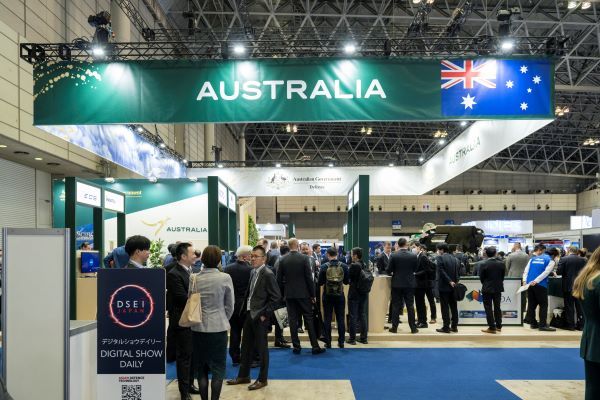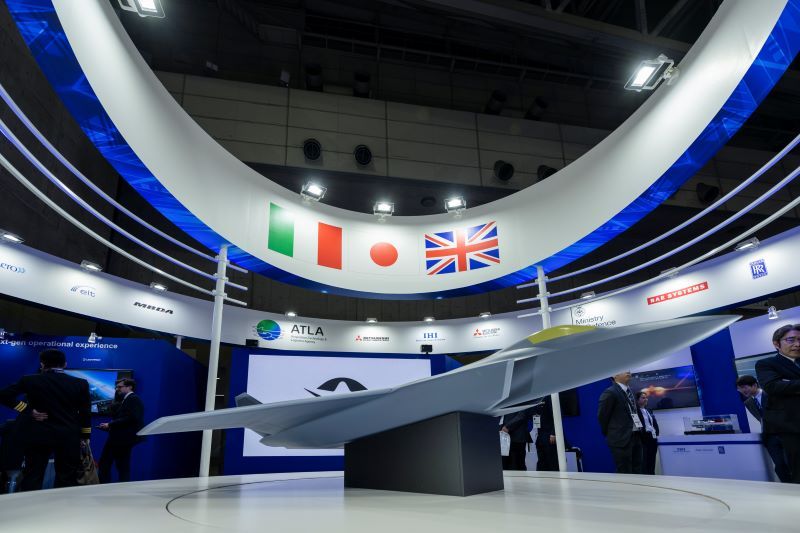Understanding the Indo-Pacific and Japan’s key allies
)
Defence partnerships involving Australia, Indonesia, and the UK, particularly in the development of next-generation fighter aircraft and naval projects, will be a central theme at DSEI Japan 2025.
DSEI Japan 2025 showcases Japan’s move to fostering international defence partnerships and expanding access to global markets. The event will feature pavilions from key allies like Australia, Indonesia and the UK, highlighting Japan’s efforts to diversify its defence collaborations beyond the US.
The UK’s presence includes a dedicated pavilion supporting initiatives like the Global Combat Air Programme (GCAP), a trilateral partnership with Japan and Italy to develop next-generation fighter jets.
Japan and Australia’s relationship has been strengthening, as both seek to ensure long-term security in the Indo-Pacific. DSEI Japan will therefore feature a large Australian pavilion – Team Defence Australia – and a delegation will attend. Emphasis will be on joint ventures in maritime security and advanced technologies.
Similarly, Japan and Indonesia’s relationship is also strengthening, with a recently established defence consultation framework, focusing on maritime security and equipment cooperation. This reflects Jakarta’s role as a critical Association of Southeast Asian Nations (ASEAN) partner.
Australia
Australia is Japan's most crucial security partner after the US. The Australia-Japan Joint Declaration on Security Cooperation (JDSC) of 2007 and the renewed 2022 version deepened and expanded cooperation to respond to the most pressing security challenges in the Indo-Pacific region.

Australia's pavilion at DSEI Japan 2023. (DSEI Japan)
The JDSC prioritises military interoperability and joint capacity-building, while the Reciprocal Access Agreement (RAA), which was signed at the same time, streamlines legal frameworks for cross-deployment of forces, shared base access and simplified procedures for joint training and operations.
Under the JDSC, both nations have expanded their advanced military exercises and deepened collaboration on long-range missile development, submarine rescue systems and integrated air defence.
Past and planned joint exercises include:
- Talisman Sabre: This large-scale bilateral exercise between Australia and the US now includes Japan, with the 2025 iteration involving amphibious landings, air combat and multinational participation.
- Bushido Guardian is a bilateral air combat exercise series initiated in 2019. In 2023, the Royal Australian Air Force’s F-35 fighter jets trained alongside Japan’s F-35 and F25A fighter jets at Komatsu Air Base, enhancing interoperability in fifth-generation fighter operations.
- Exercise Orient Shield: This year, Australia will participate for the first time in this exercise, which is traditionally the largest annual field training deployment between the US Army and Japan’s Ground Self-Defense Force.
- Exercise Pitch Black is Australia’s biennial large-force training event involving 20+ nations. Japan plans to deploy F-35 fighter jets to Pitch Black in 2026.
Australia and Japan are also partnering in the Indo-Pacific through initiatives like Partners in the Blue Pacific (focusing on critical infrastructure, disaster recovery and maritime security) and the Trilateral Partnership for Infrastructure Investment, whose projects include the installation of undersea fibre optic cables.
Naval modernisaton opportunities at DSEI Japan 2025
One of the most promising partnerships between the two countries is Project Sea 3000, an Australian naval programme which involves the procurement of up to new general-purpose frigates for AU10 billion (USD6.5 billion). Late last year, Japan's Mitsubishi Heavy Industries (MHI) and Germany’s Thyssenkrupp Marine Systems were downselected as the prime bidders on the programme.
The project will see 11 warships built for the Royal Australian Navy, three of which are planned to be constructed outside Australia. MHI is proposing an upgraded version of the Mogami-class frigates, offering advanced stealth capabilities, automation and enhanced air defence systems. A final decision on which bidder will be selected is expected later this year, with construction due to commence in 2026.
MHI will prominently showcase its initiatives at DSEI Japan. Should the company win Australia's Project Sea 3000 contract, subcontracting opportunities lie in localised production support for its Mogami-class design, including propulsion systems integration and combat suite compatibility with Australian defence networks.
The project’s plan to build some of the vessels domestically after initial overseas production creates openings for Australian firms in shipyard upgrades, sustainment infrastructure and modular mission system components.
Indonesia
In 2021, Indonesia and Japan signed a security agreement related to the transfer of defence equipment and technology, which enables joint research, development and production of defence systems like maritime patrol vessels, along with technology transfers for projects contributing to international peace and security. A bilateral joint committee oversees equipment transfers and technical cooperation.
In January 2025, the countries resumed talks on the joint development of Mogami-class stealth frigates under the agreement, with proposals to build four ships in Japan and four in Indonesian shipyards by 2028. That same month, Japan delivered high-speed patrol boats to Indonesia via its Official Security Assistance programme, enhancing maritime surveillance near the Strait of Malacca and the future capital Nusantara.
The countries have also expanded their defence cooperation through joint military exercises, focusing on maritime security and interoperability in the Indo-Pacific. Both of these are planned to continue annually.
-
Super Garuda Shield (2024) is a multilateral exercise involving Indonesia, Japan, the US and 12 other nations. It emphasises multi-domain interoperability, cyber defence, amphibious raids and live-fire drills.
-
Exercise Komodo (2025) took place in Bali and included 15 nations, with Japan participating in search-and-rescue scenarios and fleet operations to strengthen regional maritime coordination.
The UK
The UK's defence partnership with Japan is part of the country’s pivot towards the Indo-Pacific, as outlined in the 2021 Integrated Review of Security, Defence, Development and Foreign Policy and its 2023 refresh.
These documents frame the Indo-Pacific as critical to global stability and economic growth, with the UK committing to becoming "the European partner with the broadest, most integrated presence" in the region by 2030. It’s a reorientation that emphasises collaborative security, trade diversification and technological innovation – priorities that align closely with Japan’s own strategic imperatives.
Flagship collaboration: GCAP
Key to bilateral cooperation is GCAP, a trilateral initiative with Japan and Italy to develop a sixth-generation stealth fighter jet by 2035. The aircraft – designed with supersonic capabilities, advanced AI-driven systems and radar technology – aims to replace the UK’s Eurofighter Typhoon fighter jets and Japan’s F-2 fighter jets.

GCAP stand at DSEI Japan 2023. (DSEI Japan)
Synergy with AUKUS Pillar 2
Japan is currently in discussions about collaborating on specific advanced technology projects under AUKUS Pillar II, particularly in artificial intelligence, cybersecurity, and quantum technologies, areas in which Japan is also investing to protect against maritime threats.
Formal membership remains limited to the original trilateral partners – Australia, the UK and the US. By participating in both GCAP and AUKUS, the UK connects European and Indo-Pacific defence development, giving Japan access to advanced technology beyond US systems.
Operationalising the partnershipMilitary interoperability has advanced through exercises like Exercise Vigilant Isles, where UK Air Assault Brigade troops train annually with Japanese forces on Kyushu Island. The 2025 deployment of the UK’s Carrier Strike Group to Japan will deepen naval coordination, building on the 2021 HMS Queen Elizabeth deployment that spanned 40 Indo-Pacific ports.
These efforts are bolstered by the UK’s permanent naval presence through patrol vessels, which conduct joint maritime surveillance with Japan to deter illicit activities.
Diplomatically, the 2023 Hiroshima Accord cemented commitments to cross-domain cooperation in the fields of cyber and space, and ASEAN-centric regional security. Both nations now prioritise high-level defence dialogues, reciprocal base access agreements and intelligence sharing.
Explore potential partnerships at DSEI Japan 2025
DSEI Japan 2025 is the forum where international companies can understand Japan's evolving defence posture, build relationships with key stakeholders and develop informed strategies for supporting Japan's defence modernisation efforts. With a large percentage of attendees from the Indo-Pacific region and strong representation from Japanese small and medium enterprises, DSEI Japan 2025 provides an ideal environment for exploring potential industrial partnerships and understanding the local defence industrial base.
